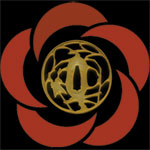 |
Hakamaby Michael Leung, Hong Kong Aikido Association Chairman// Источник: B.A.F. Newsletter, Сентябрь 2004, No 48Part of an article written for the Hong Kong Aikido Association's Newsletter by Mr. Michael Leung (H.K.A.A. Chairman) and reproduced here with Mr. Leung's kind permission. Hakama has been part of the traditional court dress of the noble and samurai classes throughout the history of Japan. The openings at the hips are to allow for the carriage of the long and short swords, a privilege of the samurai class. Hakama were normally at ankle length for ease of walking but in the dress for the high court occasions the hakama were sewn shut at the bottom and extended three to four feet behind the heels to restrict quick movements. The form of hakama still being worn today took the form of a design prevalent in the Edo period (17th and 18th centuries). Nowadays, besides being worn as a traditional costume, hakama is usually worn for the classical martial arts know as Kobudo, and for some modern Budo involving classical weapons such as Kendo and Naginata. Aikido is unique in that it is the only modern non-weapons art in which hakama is worn in training. The pleats of the hakama have symbolic significance, as these represented the virtues of Budo. Mitusgo Saotome Shihan in his book 'The principles of Aikido' devoted a chapter to 'Hakama and its meaning'. He recalled that once he forgot to bring his hakama to class and O'Sensei was very angry and stopped him from practice. O'Sensei asked him if he knew the meaning of the seven pleats in the hakama. Saotomi Shihan recalled that this prompted O'Sensei to lecture to all the uchi-deshi after the class. O'Sensei said that the seven pleats in the hakama symbolized the seven virtues of Budo: Jin (benevolence), Gi (honour or justice), Rei (courtesy and etiquette), Chi (wisdom, intelligence), Shin (sincerity), Chu (loyalty), and Ko (piety). He said that the hakama prompted all Aikido students to reflect on the nature of true Budo and wearing it symbolized the traditions that had been passed down to us from generation to generation. It was important that in our Aikido practice we must strive to polish these seven traditional virtues. The tradition of wearing hakama in training changed after the Second World War. During the immediate postwar years Japan suffered from an acute shortage of clothes and as Aikido become open to the general public many students did not possess a hakama or could not afford one. The policy in the Hombu Dojo was then changed to accommodate the social conditions and new students (mudansha) were not required to wear hakama until they attained Shodan level. For ladies, who were usually more resourceful as regards clothing, hakama would be worn after they had passed the first grade. This is the current policy at the Hombu Dojo. Traditions in other dojos and Aikido organizations, however, vary from one to another. Generally only black or blue hakama are worn nowadays in Aikido practice as the lighter colours would easily fade with suwari-waza practice. It is important to wear the hakama properly and with dignity. It must not come loose easily during practice and should be properly folded after practice for storage. It is good manners to put on your hakama in the dressing room and not besides the mats before class. If the hakama becomes loose during practice one should signal to one's partner, turn to face the other way and kneel on one knee to adjust the ties. If the hakama becomes very loose one may have to go back to the changing room to adjust the ties. It is important to perform these adjustments in a calm and dignified manner. A properly dressed and presentable individual will have great confidence in his or her Aikido and will be well respected socially. A hakama is an expensive garment but it is always wise to invest in a good quality hakama rather than in a cheaper alternative. A good hakama can last for quite a long time and still stay in shape. The traditional supplier of hakama to the Aikikai Hombu Dojo is the Iwata Company. An order with Iwata would normally take 8-10 weeks to be delivered. For length of a hakama one's order is normally based on body height. There is no difference in style between male and female hakama, but since males usually wear their belts lower than females the length of the hakama for male and female therefore differs for the same height. Iwata Company offers a guide tor ordering the correct length of hakama and it can be accessed through the internet at: http://www.alpha-net.ne.jp/users2/iwvataco/iwatatop.html |
|||
| © Рюсинкан.ру |
